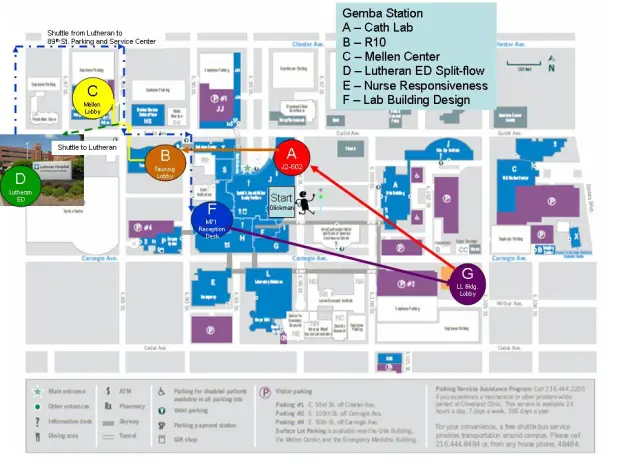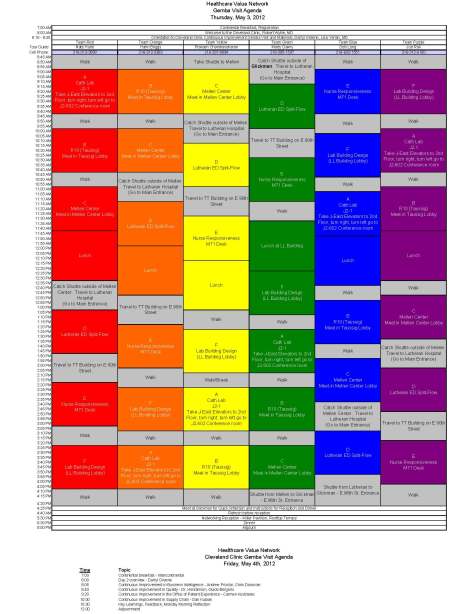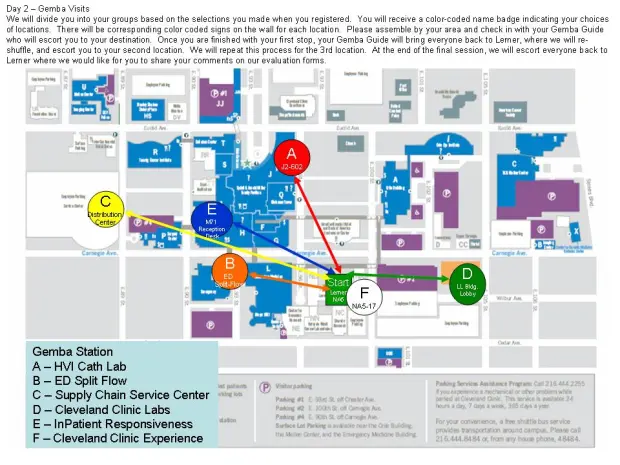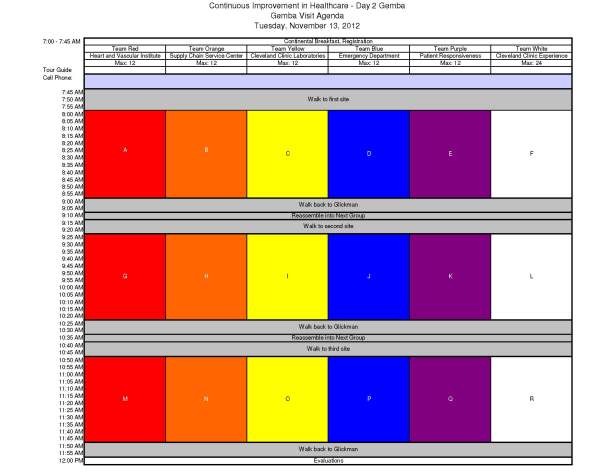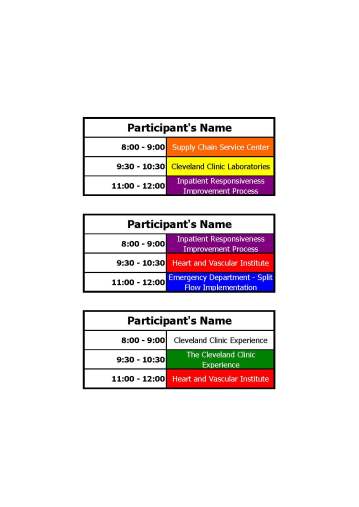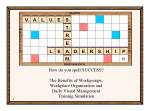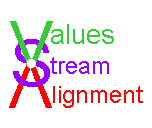Archive for category Uncategorized
Functional Management: The Organization as Patient Webinar
Posted by valuesstreamldr in Uncategorized on January 23, 2019

It has been awhile since I’ve written here – nearly 5 years. Yikes! Life happens! I’m happy to report that all is well and I’m really enjoying working with the Cleveland Clinic Akron General team as Program Director, Continuous Improvement.
I wanted to inform you that I will be a guest on the Institute for Enterprise Excellence webinar this Friday, January 25 from 1:00 – 2:00 p.m. EST.
I will be sharing my thoughts on a concept I call “Functional Management – The Organization as Patient”. Click here for a brief synopsis and links to the webinar.
Join me on Friday and then let’s continue the discussion. Your feedback and thoughts are most welcomed!
Gemba visit logistics lessons…adapt, don’t adopt.
Posted by valuesstreamldr in Uncategorized on November 28, 2012
Some things need to be seen to be believed, while others need to be believed before they can be seen.
During the planning sessions for our recent Continuous Improvement in Healthcare Conference at the Cleveland Clinic, we were discussing the logistics of our optional Gemba day visit for our guests.
Earlier this year, we hosted approximately 50 people from member organizations in the Healthcare Value Network during a Gemba visit. We selected six sites to visit, broke the larger group into 6 smaller groups and established a golf tournament “shotgun” start process that had each group starting at a different location, then rotating counterclockwise through the series of 6 locations throughout the day. We even added a visit to one of our regional hospitals one week prior to the event, requiring a 30 minute shuttle drive.
The day came off without a hitch and the best words I heard all day were from a participant who said “We haven’t seen any of the other groups!”. To me, that indicated success, because we designed the process to keep the groups apart. If they had seen each other, it would have meant that our Gemba guides or host locations had not met their takt time. Everyone had a full day and made it back to where they belonged at the end of the day. We received very positive feedback on the planning and logistics.
So when we started to plan the Gemba visit for our recent Conference, everyone wanted to use the same process. Why mess with success? However, things were different this time. Instead of a full day, we only had a half day. We also were planning on hosting up to 72 people vs. 50. One other big difference, we were asking people to pay to see our sites, while the HVN Gemba visit represented an obligation on our part to share with other member organizations. As a result, we needed to ensure that the visit was value-added.
Since we only had time for 3 site visits, planning team members suggested we establish 3 routes and force participants to choose a pre-determined set of sites. None of us felt qualified enough to guess on how to group 3 sites together to satisfy everyone. So how to manage the logistics of such a visit? Additional constraints included keeping the group size to below 12 participants, while offering enough locations to accommodate up to 72 people.
We choose a “FedEx” hub and spoke process. Participants would be given their choice of 3 of the 6 available sites and rather than rotating people from site to site, we would gather in a central location, send people out to their sites, then bring them back to the central location, shuffle, then go back out.
Participants received a name tag with their color-coded choices for their 3 gemba sites. We posted color-coded Gemba signs in the Gemba central hub location and when every group had returned to the central hub, we asked everyone to “shuffle” for their next site. Gemba guides also had color-coded name tags to help with the proper identification of the location of the tour.
As we gathered at the start of the day, everyone was anxious to see how the “Gemba Shuffle” would work. Participants signed in, received their name badges and we gathered in a conference room to explain the logistics of the day. Once we explained the process, everyone went to the hallway to find their group for their first gemba stop. Gemba guides were given a list of people scheduled for each time slot and checked off participants as they gathered. Once they accounted for everyone, the gemba guides set forth on their journey while we sat back and awaited to see if everyone returned on time. As the first groups started to return, our focus shifted to seeing if the “shuffle” would occur without a hitch. While attendees were waiting for their next trip, we provided “posters” of improvement projects that our CI group had worked on throughout the year to showcase some of our work. Attendees found the posters an interesting distraction while waiting. At the appointed time, I made an announcement that it was time to “shuffle” and report to their next Gemba station. People moved, assembled at the right location and went off to visit their second site. The process repeated one more time and everyone ended up seeing what they wanted to see and no one was lost.
It worked!
Benchmarking is necessary sometimes in order for people to see a process work before they believe that it will. Other times, proper planning and thinking through a process are required before the end results can be seen. The key is to not blindly try to replicate a successful tool or system, rather, understand the problem that the tool or system is trying to solve, then adapt, don’t adopt to your current problem.
How do you spell success? An AME Workshop
Posted by valuesstreamldr in Uncategorized on September 22, 2012
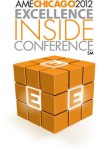 I’ve previously shared some of my story from my time at Ford and how I learned about Lean manufacturing through the development of the Cleveland Production System and eventually serving as a Ford Production System coach for the Powertrain division.
I’ve previously shared some of my story from my time at Ford and how I learned about Lean manufacturing through the development of the Cleveland Production System and eventually serving as a Ford Production System coach for the Powertrain division.
Here are some additional details that have led to an opportunity to facilitate a half-day workshop at the upcoming AME Conference in Chicago on October 19th.
The Background:
In 1997, following Cleveland Engine Plant 2’s successful challenge for what was then called the Shingo Prize for Manufacturing Excellence, I was given the opportunity to move over to Cleveland Engine Plant 1 to help them implement the Ford Production System and transition to a team-based organization structure.
There were a few challenges associated with this.
First, the overall environment at the plant was not real conducive to change. They had recently shut down one engine line (4.9L), while the remaining engine line (5.0L) had just lost 50% of its production volume.
The transition to a team-based structure was set to take place in a plant where the employees working there had decided that they didn’t want to transfer to CEP 2 when it opened several years earlier with a team-based approach. CEP 1 Employees were comfortable with their seniority-based structure where high seniority employees could “bid” on easier jobs, while employees with lesser seniority were stuck in difficult jobs. The only ones who were excited about the job rotation that came with the new contract negotiated with the UAW were the lower seniority employees who would see some relief from their 8 hour days doing the same, difficult job.
Did I mention that the plant was also scheduled to close in three years? This had already been decided at the Corporate level and communicated to the local workforce.
So, together with my UAW counterpart, John Nahornyj, we set out to create a training plan that would eventually accomplish the goal of implementing wall-to-wall teams and achieving what was then called “Checkpoint A” of the Ford Production System.
One of the many things we did was to develop a 3-hour simulation for implementing “lean” principles and tools. The simulation utilized the board game Scrabble to demonstrate the value of teamwork, workplace organization and the way to track a new set of production-based metrics to direct continuous improvement efforts. The simulation, along with a host of other ideas we implemented resulted in the plant turning around its performance and eventually earning a new engine line that kept the plant open.
Several years ago, in response to a post on the Lean.org manufacturing forum about simple 5S simulations, I responded with my story about utilizing Scrabble. The response to my post was overwhelming – over 31,000 views to date with several hundred requests for details about the simulation. It wasn’t quite the same response that Bob Petruska’s Pizza Game received, but it was a notable post in LEI lore. Not being prepared for the response, I struggled to keep up with the correspondence and eventually posted the PowerPoint presentation detailing how to conduct the exercise.
This stopped the requests for the most part, however, I was never really sure if people “got it” and implemented it.
I do know that the exercise works in different countries. I had a student from one of my lean classes take the exercise to China to teach the concepts at one of their suppliers. I also had someone send me a Spanish translation of the exercise. It has been a fun diversion for the past 10 years or so.
The Workshop
Earlier this year, I heard that my friend, Richard Evans was looking for half-day workshops for the up-coming AME Conference in Chicago on October 19th. On a whim, I submitted the required forms for consideration and received confirmation that my workshop was approved and is on the agenda.
So for those of you who may have seen the exercise on Lean.org, or for those of you interested in seeing a fun, engaging and informative workshop on the value of work groups, the magic of workplace organization and the value of using metrics to drive the right Continuous Improvement behaviors, then join me in Chicago. I’m looking forward to seeing you.
An EPIC (Engine Plant In Cleveland) story
Posted by valuesstreamldr in Lean Principles, Shingo, Systems, Tools, Uncategorized on September 9, 2011
Working at Ford in the early 1990’s, I had the privilege of learning about lean manufacturing from some of the best lean thinkers at the time. Looking to develop and implement a production system, Gifford Brown, our plant manager, sought the assistance of key ex-Toyota Georgetown powertrain leaders.
Russ Scaffide, John Allen, Dwight Clark and Bill Costantino joined the Cleveland Engine Plant 2 (CEP2) team as consultants and helped author and implement what was then called the Cleveland Production System.
The Cleveland Production System (CPS) became the forerunner to the modern Ford Production System (FPS), and its implementation at CEP 2 led to the plant being recognized with the Shingo Prize for Excellence in Manufacturing in 1996.
My role (as a cost analyst at the time) in the development of the CPS, in addition to taking the handwritten model and creating the slide above, was to proof-read the documents that were created. I was new to manufacturing, however, my prior background at what was then Ernst & Whinney‘s National Marketing headquarters in Cleveland, included conducting secondary market research on potential client companies, their industries, officers, directors and our competitors. We used this data to support the writing of major audit and management consulting proposals, which we were also responsible for proof-reading – a valuable skill that I’ve used to learn as much as I can throughout my career.
Proof-reading the early documentation of the CPS gave me the opportunity to learn about this new way of thinking in manufacturing and because I had less to un-learn, I was able to pick up on the concepts quickly and contribute to the discussion.
The model – and its implementation – with Ford and UAW leaders responsible for jointly championing and teaching the individual elements, served as a visual reminder of our responsibilities. Our role was to take all of these lean tools, systems and principles and create value for the customer through continuous process improvement and the identification and elimination of waste.
Attending the initial training, then eventually becoming a trainer for the system, there was one thing that always bothered me about the model. The model placed itself at the center, rather than the customer. Our model seemed to put all of its weight on top of the customer and never seemed quite right.
I sought to reconfigure the model as a “Focus within a Framework”. I placed the customer at the center of the model, and then built the framework with the “pillars” of the system – People, Added Value, Just-in-Time, and Performance Measurements. Once the focus was placed within the framework, I then used the elements of the production system to create the web. As our plant was a supplier to Ford assembly plants around the world, I used the (new at the time) catch phrase “Worldwide Web” to attract the attention of attendees at a joint Ford / UAW quality conference in Dearborn in 1996.
My use of a spider’s web as an analogy for a production system came from several places. First, my favorite bedtime story to read to my kids was E.B. White‘s Charlotte’s Web. In the story, Charlotte, a spider, weaves words into her web to describe Wilbur, a runt pig who is in constant fear of being slaughtered as he fattens up. Charlotte seeks to save Wilbur by pointing out his better qualities in such “web posts” as “Some Pig“, “Terrific”, “Radiant” and finally “Humble”. I started to view a production system much like a spider’s web. (I’ll discuss the irony of the word “Humble” being the word that finally saved Wilbur in an up-coming post.)
The other influence on my spider thinking came from a student who I was supervising in my first job out of college at a major retail store. She was working in the evening and when asked about getting stock out of the storeroom and onto the shelves, commented “if it wasn’t for the customers, I would be able to get my work done.” This view of the customer as a nuisance fit nicely with the transformation in thinking required to move from mass (where the customer is sometimes viewed as a nuisance) to lean, (where the customer is nourishment).
In my web analogy, the contrast between the way that humans view flying insects as a nuisance and the way that spider’s view flying insects as nourishment emerged. In fact, a spider’s existence is dependent upon its ability to capture and hold onto insects that move in and out of its “Window of Opportunity”. Much like customers’ disposable income should be viewed as the lifeblood of any organization.
If the spider’s web doesn’t cover the entire opening, potential nourishment can fly through without being captured. If the web breaks, the ability of the spider to quickly react and fix the problem directly impacts the spider’s future viability.
An organization’s leaders are responsible for identifying the organization’s Window of Opportunity, providing a focus on the customer, and creating the systems that enable employees to create value to capture and hold onto customers. Quick reactions to breakdowns and weaknesses in the systems when identified, are necessary to maintain organizational stability and provide continued growth.
Principles – the focus and the framework of any organization – linked through systems and tools enable employees to create and provide increasing value to customers. Thus, our “Window of Opportunity” defines how well our Principles connect to our customers and our ability to create value through the continuous improvement in our systems and tools and the identification and elimination of waste.
Continual assessment of the effectiveness of our systems and adjustments when and where necessary will determine the amount of nourishment we receive.
Unfortunately, the model, which I found attractive and intuitive, never caught on as the CPS morphed into the FPS. However, the learning I obtained from creating it and thinking through all of the various messages it conveys have helped me as a frame of reference when assessing other lean organizations. It was especially helpful the following year when I moved to Cleveland Engine Plant 1 to implement the new Ford Production System in a plant that was in a slightly different emotional state. I’ll share that story in my next post.
Are you capturing your customer’s disposable income that is moving in and out of your Window of Opportunity? Are your systems complete and connected? Do you react quickly to signals your customers are sending, indicating their presence in your window? When your systems are weak or broken, do you respond immediately to minimize the loss of potential customers? Do you view your customers as a nuisance or nourishment?
4-H booth set-up day
Posted by valuesstreamldr in Uncategorized on July 31, 2011
The Medina County Fair opens on Monday, Aug. 1st. Yesterday, Saturday, was the day that hundreds of young 4-H members and their advisers swarmed the fairgrounds on booth set-up day. In addition to the animals being brought to the fairgrounds to be housed all week for fair goers to see and 4-H members to show in highly competitive judging, 4-H clubs set up booths in the 4-H barn to showcase members projects that were worked on all year. The highlight of booth set-up day is the first opportunity to purchase a milkshake from the 4-H milkshake booth. Hand-dipped ice cream with many flavors to choose from is mixed with milk by 4-H volunteers who run the milkshake booth as a business. They organize early in the year, elect officers, delegate responsibilities and start recruiting volunteers to work the booth during the week-long fair. It is easily the busiest booth at the fair.
For those of you who may not be aware of 4-H, the organization was founded in Ohio by A.B. Graham as a supplement to the public education system. The motto of 4-H is, “To Make the Best, Better” . Sounds like a lean principle to me.
Over the years, as my children were growing up, my wife and I became 4-H advisors. My wife, Lisa, started a club for home-schoolers and she was recognized at the State level for recruitment.
Our daughters, Sara and Nina both were recognized as Outstanding Court members – two years each!
This was due to their hard work and efforts with their annual projects in sewing, cooking, small animals, cake decorating and others. My wife’s attention to helping teach my kids and other club members truly helped make the best, better.
My favorite time of the year was booth set-up. I became the un-official champion of this annual project. Each year, the fair committee chooses an overall theme for the fair, then 4-H clubs design booths around that theme to display members projects. The club advisors work with the club members to choose a theme for the booth that reflects the overall theme for the fair. The kids then share ideas on how best to design the booth and the planning for booth set-up day begins in earnest. With a plan in mind, the kids work with adults to acquire the materials needed for the booth construction (Thanks to A-Kobak Container for donating the cardboard) and on Saturday morning, Mr. Pettry and several of the senior club members would gather to construct the frame of the booth. Once the frame was up, Mrs. Pettry and the other advisors would work with the kids to decorate the booth. Each booth would then be judged by a committee of 4-H officials looking for specific criteria and would award Outstanding Booth status to those booths who met the criteria for the booth presentation.
Here are a few of my favorite Homespun Heroes’ outstanding Booth award winners from the turn of the century.
The Y4H booth was centered around the Y2K theme and the Scrabble booth was created to highlight the fundamentals of 4-H. (You’ll hear more about my use of Scrabble in future posts.)
So the purpose of this post? Values obviously go beyond the workplace and greatly influence our lives. When the values of the organizations we belong to align with our personal values, great satisfaction occurs. 4-H is a terrific organization for our children to learn leadership lessons and other life skills.
Perhaps the greatest display of aligned values occurred in 2001 in the wake of a tragic accident at the start of the fair, on booth set-up day. A steam engine explosion killed five people and injured at least 35 others. It was a devastating event for the families of the victims and sent a shock wave throughout the community. What happened later on during the week at the livestock auctions still brings a tear to my eye. The kids came up with a plan to donate half of their earnings from the auction of their livestock to a fund that was set up for the families of the victims. It was amazing to watch as each kid brought their animal into the auction area and announced that they would donate half of their earnings to the fund. The beautiful part of the story is that the community responded with record prices for the animals, thus ensuring that the kids were able to earn as much as they had in the past, however, the families of the victims also received over $20,000 from the 4-H kids. This is what aligned values looks and feels like.
Our family has greatly benefitted from 4-H and the Medina County fair. Working on the projects throughout the year, culminating with the display of projects during fair week for all fair goers to admire.
In a future post, I’ll write about the lessons in visual management that my father taught me when he was running his church’s food booth at the fair.
If you haven’t already visited your local county fair, please do yourself a favor and go – not for the rides and gaming attractions – but for the joy of watching kids show their animals, display their projects, or make a milkshake.
Are values enough?
Posted by valuesstreamldr in Uncategorized on July 28, 2011
The linked article caught my eye recently and I thought I would share some thoughts on The Business of Communicating Values.
The discussion of Values – the way that they flow through an organization and are aligned vertically, horizontally and even diagonally across the organization and drive behaviors is the purpose of this blog.
I had a good day earlier this week. My morning started as a facilitator of the Cleveland Clinic Experience for a group of our incoming residents. Over 40,000 Clinic caregivers have been through this 3 hour program that aligns all caregivers around the Clinic’s Mission, Vision, Values and expected service behaviors. Two hundred attendees seated at tables of ten people, with a facilitator at each table to guide the discussion, discuss their roles in providing our patients with world-class care.
It has been great having the opportunity to talk with fellow caregivers and hear their stories. Yesterday, I was struck by the diversity of the group I was facilitating. Young doctors from Las Vegas, Utah, Chicago, Boston, Cleveland, Russia, China, India shared their experiences. We talked about how we will all need to work as a team to provide each other with the best possible employee experience. This positive employee experience reinforces and supports our ability to provide our patients with the best possible patient experience as we continue to provide the best possible clinical outcomes. The discussion is centered around how we all need to adhere to our stated values of Integrity, Teamwork, Innovation, Service, Quality and Compassion.
Where stated organizational values differ from individually practiced values, organizations suffer from waste. Wasted time, poor communication, bad decisions, waiting due to confusion, and on and on. Being able to identify where and why this misalignment occurs is where organizational development and lean systems and tools are used to align the organization towards its stated mission and goals.
Clearly defined roles and responsibilities along with clear communication channels and standards provide employees the freedom and confidence to make decisions. It is the ultimate expression of the lean principle of “Respect for the Individual”.
I’ve been fortunate to attend some of the best training on organizations that exists and have learned about organizational and individual behavior from the very knowledgable people I’ve worked with. The Cleveland Clinic Experience is an ambitious, well-designed cultural alignment tool and has served its purpose to communicate the Mission, Values and expected service behaviors to all caregivers and anchor them to our Guiding Principle of “Patients First”. We will be assessing the results over time to measure the effectiveness of this alignment exercise.
So how are other organizations aligning and assessing their values?
Organizations which are using the Shingo Prize model benefit from a well-thought out assessment model that focuses on assessing behaviors – in addition to business results – to determine the extent to which the organizatoin has transformed into a Principle-based organization. In addition to the assessment model, the Shingo Prize has crafted a great visual of what the organizational transformation should look like.
The training offered to Shingo Prize examiners is by far the best I’ve attended. In it, the discussion about values goes deeper than any other discussion I’ve heard or read about.
To briefly summarize a key point in the model – stated values are important for organizations and the individuals working in them, however, those values need to be anchored to the proper guiding principles. Stated values and alignment are not enough. It is the Guiding Principles that determine the direction the organization takes.
The example used in the training lists the values of “teamwork”, “innovation”, “precision”, and “loyalty”. These values can be claimed and displayed by many organizations – including a gang of robbers who steal from others. Without guiding principles to anchor to, such as Respect for the Individual, values are just descriptive words. When anchored to guiding principles, values drive desired behaviors.
The guiding principles of operational excellence as expressed in the Shingo Prize Model provide organizations with a framework to work within and the transformational model presented helps organizations understand how Guiding Principles need to be supported by Systems that are aligned with the Principles. These systems are then used to select the appropriate Tools to achieve the desired Results that affirm the organization’s stated Guiding Principles, which are apparent in the behavioral evidence observed in the culture of the organization. Brilliant!

The HBR article reference at the top of this post is good, however, I would encourage you to take some time to read the Shingo Prize model and guidelines to get a glimpse of what Operational Excellence looks like. This is the stuff that we need to be teaching in our Business and Medical schools.
(Disclaimer – This post does not represent an endorsement of the Shingo Prize model by the Cleveland Clinic. The opinions expressed are based on my personal experience as a Shingo Prize examiner and a member of the Healthcare Value Network’s assessment development team.)
Values Stream Alignment
Posted by valuesstreamldr in Uncategorized on July 10, 2011
Welcome to Values Stream Alignment. My name is Tim Pettry. I work at the Cleveland Clinic, implementing and facilitating continuous improvement activities within the Neurological Institute. For the past 20 years, I’ve been a student and teacher of Lean and have finally decided to take the plunge, and start sharing my thoughts on lean and organizational development.
My blog’s name, Values Stream Alignment comes from an observation I had while working at Ford. Lean practitioners use value stream mapping to identify where products and information stop flowing, thus exposing waste. I recognized that where an organization’s VALUES stop flowing, there is greater waste. The waste of human potential. Thus the need for mapping the flow of Values in an organization to see where they are mis-aligned and implement organizational development mechanisms to align the thoughts and actions of everyone in the organization. This application of a basic lean principle of flow to the world of organizational development has been a focus of mine since 1997 that I have continued to develop and refine.
I have been a Shingo Prize examiner since 1996 when I helped lead Ford‘s Cleveland Engine Plant 2’s successful challenge for the Shingo Prize. For the past 5 years, I’ve been involved with the SME / AME / Shingo Prize / ASQ Lean Certification program. First as a writer of exam questions, then as an appointed member of the Oversight and Appeals Committee, representing the Shingo Prize organization. In 2010, I served as the elected Chairman of this committee.
In late 2009, I became involved with the Healthcare Value Network as a member of the Assessment development team, where we are using the Shingo Prize model to help healthcare organizations focus their continuous improvement activities. This alignment of my participation in outside organizations and their objectives serves as my model for Values Stream Alignment.
My posts will draw on my struggles and successes with aligning people and organizations around the principles of lean as outlined in the Shingo Model.
I’m looking forward to the exchange of ideas!
Blog contents copyright © 2011 Values Stream Alignment. The views expressed here are solely my own personal views and not those of my past or present employers.
